
Collins is a tiny lunar impact crater located on the southern part of the Mare Tranquillitatis. It is located about 25 kilometers to the north of the Apollo 11 landing site, Tranquility Base. Named after American astronaut Michael Collins, the crater is the central member of the row of three craters named in honor of the Apollo 11 crew members. About 15 kilometers to the west-northwest is the landing site of the Surveyor 5 lunar probe.

Lansberg is a lunar impact crater on the Mare Insularum. It can be located by following a line south-southwest from Copernicus to Reinhold, then southwest to Lansberg. The crater has a high rim and a central mountain. There are terraces along the inner walls, and the tops have slumped to produce a sharp edge. This formation is not noticeably eroded, and there are no significant impact craters within the interior.

Dollond is a small lunar impact crater that is located in the central region of the Moon, to the north of the crater Abulfeda. It was named after British optician John Dollond. Due west of Dollond is Anděl. Dollond is circular and cone shaped, with a tiny floor at the midpoint of the sloping interior walls.

Ewen Adair Whitaker was a British-born astronomer who specialized in lunar studies. During World War II he was engaged in quality control for the lead sheathing of hollow cables strung under the English Channel as part of the "Pipe Line Under The Ocean" Project (PLUTO) to supply gasoline to Allied military vehicles in France. After the war, he obtained a position at the Royal Greenwich Observatory working on the UV spectra of stars, but became interested in lunar studies. As a sideline, Whitaker drew and published the first accurate chart of the South Polar area of the Moon in 1954, and served as director of the Lunar Section of the British Astronomical Association.
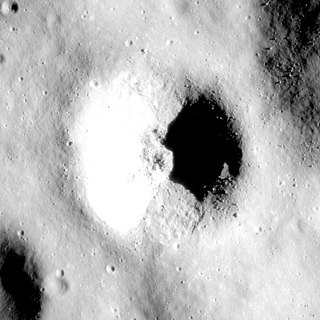
North Ray crater is a small crater in the Descartes Highlands of the Moon visited by the astronauts of Apollo 16. The name of the crater was formally adopted by the IAU in 1973. It is the largest crater sampled by astronauts during the Apollo program.
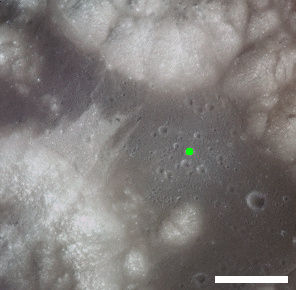
Steno-Apollo is a feature on Earth's Moon, a crater in Taurus-Littrow valley. Astronauts Eugene Cernan and Harrison Schmitt visited it in 1972, on the Apollo 17 mission. The astronauts referred to it simply as Steno during the mission. The north rim of Steno is Geology Station 1 of the mission.

Nansen-Apollo is a feature on Earth's Moon, a crater in Taurus-Littrow valley, at the base of the South Massif. Astronauts Eugene Cernan and Harrison Schmitt visited it in 1972, on the Apollo 17 mission. The astronauts referred to it simply as Nansen during the mission. Geology Station 2 of the mission was located at Nansen. Nansen is located in the 'light mantle' which is almost certainly an avalanche deposit from the South Massif.
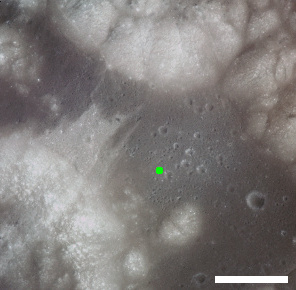
Mackin is a feature on Earth's Moon, a crater in Taurus–Littrow valley. Astronauts Eugene Cernan and Harrison Schmitt landed north of it in 1972, on the Apollo 17 mission, but did not visit it.
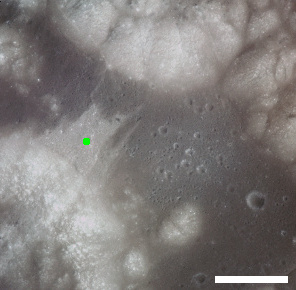
Lara is a feature on Earth's Moon, a crater in Taurus-Littrow valley. Astronauts Eugene Cernan and Harrison Schmitt visited it in 1972, on the Apollo 17 mission, during EVA 2. Geology Station 3 of the mission is located on the northeast rim of Lara.

Horatio is a feature on Earth's Moon, a crater in Taurus-Littrow valley. Astronauts Eugene Cernan and Harrison Schmitt drove the Lunar Roving Vehicle along its south rim in 1972, on the Apollo 17 mission, but did not stop.

Hess-Apollo is a feature on Earth's Moon, a crater in Taurus–Littrow valley. Astronauts Eugene Cernan and Harrison Schmitt landed north of it in 1972, on the Apollo 17 mission, but did not visit it. The astronauts referred to it simply as Hess during the mission.
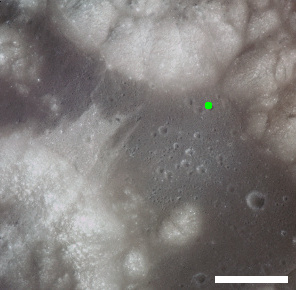
Cochise is a feature on Earth's Moon, a crater in Taurus-Littrow valley. Astronauts Eugene Cernan and Harrison Schmitt landed southwest of it in 1972, on the Apollo 17 mission. They drove along its rim in the rover during EVA 3, but did not stop.

Powell is a feature on Earth's Moon, a crater in Taurus–Littrow valley. Astronauts Eugene Cernan and Harrison Schmitt landed less than 1 km northeast of it in 1972, on the Apollo 17 mission, but they did not visit it.

Little West is a small crater in Mare Tranquillitatis on the Moon, east of the Apollo 11 landing site known as Tranquility Base.

Surveyor crater is a small crater in Oceanus Procellarum on the Moon. The name of the crater was formally adopted by the IAU in 1973.

Head crater is a small crater in Oceanus Procellarum on the Moon. The name of the crater was formally adopted by the IAU in 1973.

Bench crater is a small crater in Oceanus Procellarum on the Moon. The name of the crater was formally adopted by the IAU in 1973.

Halo crater is a small crater in Oceanus Procellarum on the Moon. The name of the crater was formally adopted by the IAU in 1973.

Cone crater is a small crater in the Fra Mauro highlands, north of Fra Mauro crater, on the Moon. The name of the crater was formally adopted by the IAU in 1973.

Middle Crescent crater is a small crater in Oceanus Procellarum on the Moon. The name of the crater was formally adopted by the IAU in 1973.





















